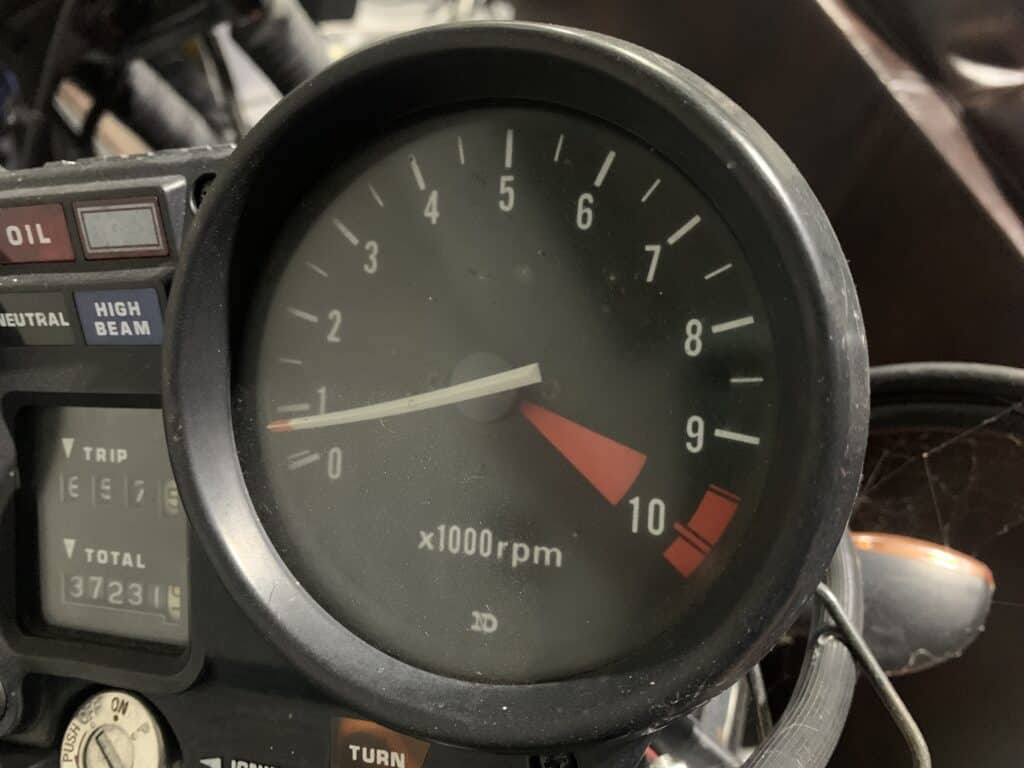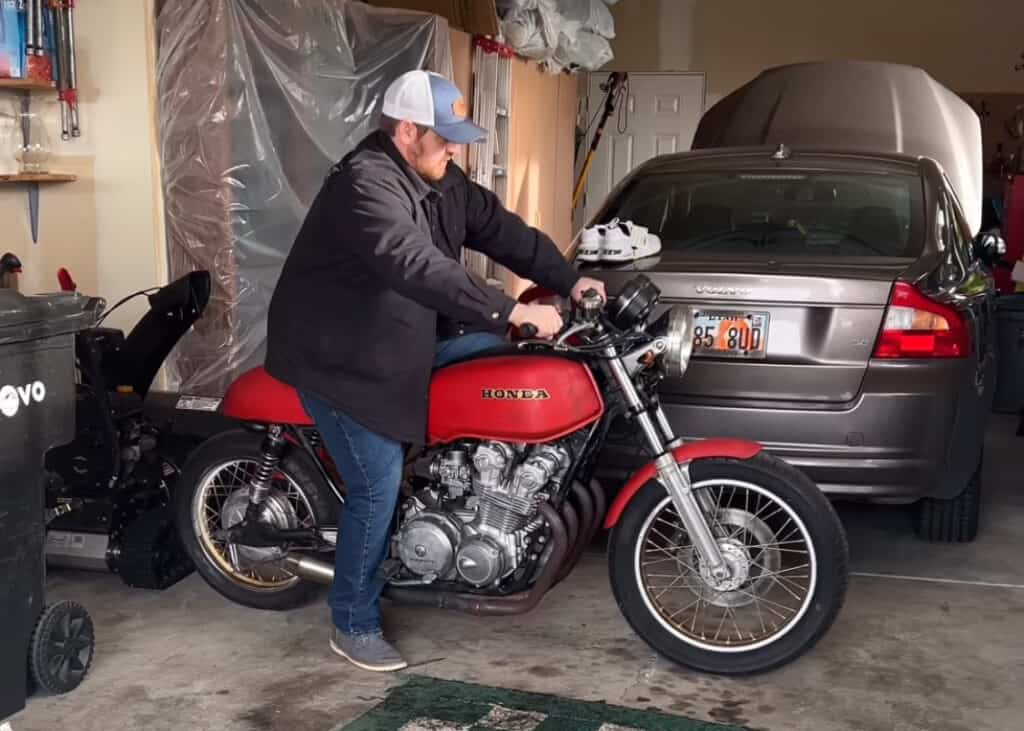
Whether you’ve heard a motorcyclist rev their engine or you’ve been known to rev the engine of your own bike, you may be wondering if it’s bad for a motorcycle to do that.
Is it bad to rev your motorcycle engine? For the most part, it is not bad for a motorcycle engine to be revved whether it be in neutral or in gear. However, a single high rev should not last more than a few seconds because that can cause damage to the cylinder walls and pistons as they overheat.
Having owned several motorcycles myself, revving the engine has become tradition during the appropriate times. This article will explain further what happens in a motorcycle engine during revving and when it is and isn’t appropriate to do it.
What Happens In A Motorcycle Engine During Revs
Most people in the world have revved an engine or at least heard one at some point in their life. Because it can be so loud, many people assume it’s bad for the engine to do it.
The term “rev” refers to the revolution of an engine per minute. When you rev an engine, you are essentially increasing the speed of the revolution of the motorcycle’s engine by using the throttle, especially while the clutch is disengaged.
When you pull the throttle and you rev your motorcycle, more vacuum pressure is created so it’s sucking in more air. When more air is sucked in that means more fuel is also sucked in. So really a throttle is more of an air pedal rather than a gas pedal.
With the increase of more air and fuel being sucked in to the engine, combustion within the engine happens a lot quicker and, in turn, pushes the pistons up and down faster and spins the crankshaft more swiftly.
Engine revving is so loud due to the combustion sequence happening faster so it’s pushing a lot more air out of the exhaust valve through the exhaust pipe. For some motorcycles, revving sounds a lot louder because the owner made some modifications to the exhaust.
Now that revving has been explained, you can see that revving an engine usually doesn’t cause much harm to it because it’s just speeding up what the engine is already doing. Motorcycles were made to rev and they were made to rev a lot higher than car engines. The average motorcycle revs to about 10,000 RPM’s compared to an average car that can go up to about 7,000 RPM’s.
However, revving an engine for a long period of time can eventually cause damage. When I say rev your engine for a long period of time, I mean doing one single rev at a high RPM for longer than five to ten seconds.
At this point, the pistons are moving against the cylinder walls at a constant high speed which is something they were not meant to do. Despite the oil inside the engine that is lubricating it, the amount of friction and heat that a continuous long rev can create could ultimately cause them to fuse.
I can see why people enjoy revving their engines, especially when it sounds really good. But there is absolutely no reason to be doing a single high rev for more than a few seconds. It sounds off and puts your motorcycle engine at risk for damage.
I personally almost found this out the hard way with my second motorcycle. It was a project bike I was restoring and I was trying to push it to the limit and see how high I could rev it. Luckily it gave me a few warnings beforehand and I immediately stopped, but I could quickly see the potential damage I could have caused.
Is It Bad To Rev A Motorcycle To Warm It Up?

If you have a carbureted motorcycle engine, sometimes it can be a little tricky to get it to stay running especially during the cold winter months. Some suggest using revs to warm up the engine while others argue that it’s harmful for the engine to do that.
It’s actually just fine to rev a motorcycle when you first start it to get it warmed up. In fact, most motorcycles need this in order to stay running. This applies mostly to carbureted motorcycles (which is the majority of motorcycles on the road).
When you start it up, you have to rev up the motorcycle a little bit. It’s usually not necessary to go full throttle when you first start it. Once the engine has been warmed up, motorcycles will idle by themselves much easier and they can run a lot better once you go out for a ride.
Often times if you try to start a carbureted motorcycle and just let it sit (again, especially during the colder months), the motorcycle will usually just stall out.
I once had a 1969 TR25W Trophy that required me to kick start it and rev it up to about 1,000 RPM’s and hold it there for 1-2 minutes. That would warm up the engine completely and it would idle just fine by itself. If it was cold outside, I usually needed to rev it to a little higher RPM.
Is It Legal To Rev In City Limits?
It’s important to be mindful of neighbors and the time of day you’ll be revving your motorcycle engine. If you’re sitting there revving your motorcycle at 10:00 at night on a school night, I doubt your neighbors will take too kindly to that.
Cities have noise ordinances that you’ll need to follow. There is usually a decibel amount that each city limits to; this is specifically made for cars and motorcycle riders. If your revving is louder than a certain decibel, police have every right to pull you over and give you a ticket.
I had a friend in high school that had a mustang that had cut out exhaust. He would dump the exhaust before the mufflers and it was way too loud. He received probably over a hundred tickets because his exhaust was so intense.
If you’re driving down the road and do an occasional rev, you’ll probably be fine and won’t get into trouble. But if you’re being annoying about it and constantly revving your engine, either someone will call the police on you or the police will track you down (which won’t be hard) and give you a ticket.
Revving vs. Redlining: Some Things You May Not Know
Some people have asked me if there is a difference between revving and redlining a motorcycle engine. The answer to that depends on how you do your revving.
Redlining a motorcycle engine means revving the RPM’s up to the red highlighted numbers, usually between 7-10 RPM’s. It may be startling to some if that needle passes over into the red zone.
While it’s not advised to constantly redline your motorcycle engine, again it doesn’t do much harm in moderation. The engineers who created that engine knew what they were doing when they made it have the ability to rev that high. So really the main difference between revving and redlining is that redlining just means you are revving to the highest RPM’s the motorcycle is capable of doing.
You may have heard an old saying that states “a redline a day keeps the carbon away” or “a redline a day keeps the mechanic away.” These statements portrays an old wives tale that says if you redline a motorcycle once a day, the carbon deposits inside the engine will be burned which will ultimately prevent problems in the future.
This is kind of a big argument in the automotive world. Some say it’s a myth while others swear by it. In actuality, redlining an older motorcycle can have it’s benefits, such as burning off those carbon deposits that may have built up in the engine. Newer motorcycles don’t need to do this mainly because of updated fuel systems that already take care of those carbon deposits.
Conclusion
Revving a motorcycle engine isn’t necessarily bad, but a lot of that depends on how you do it. Revving in moderation can actually have its benefits, such as warming up the motorcycle or getting rid of those carbon deposits. However, going full throttle for longer than 5-10 seconds will put too much stress on the engine and may cause internal damage.
How often do you guys rev your motorcycle engine? Have you seen any benefits from doing so or do you have any strong opinions that this is totally something you should not do?
Related Questions
What should you do if your motorcycle engine is flooded? When your motorcycle engine is flooded, the first thing you should do is wait 15 minutes for the gas in the engine to dissipate. If that doesn’t work, you will need to manually take out the excess fuel inside the engine with a cloth. Click here to see an article I wrote about how to handle a flooded motorcycle engine.
Is it bad to rev a car engine? In some cases, it may be bad to rev a car engine. Revving a car engine is a little different from revving a motorcycle engine because cars don’t have as high of an RMP capacity. Some major damage can be made if a car engine is revved without getting warmed up first.
